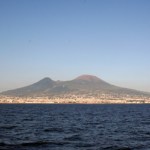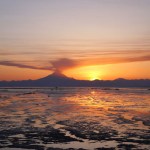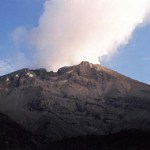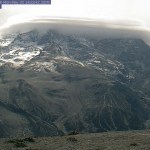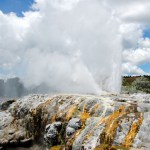volcanic hazards
The Q&A post will be coming over the weekend (there's still time to send me a question!)
Icy cold volcanoes (well, geysers) on Enceladus, a moon of Saturn.
In the meantime, here are a few quick hits:
Mt. Cleveland in the Aleutians had a small eruption. The plume was only ~15,000 feet / ~3 km. Cleveland is one of the more active volcanoes in the Aleutians, so this eruption is not out of the norm.
Landslides and rockfalls at Arenal (in spanish) in Costa Rica continue to prompt evacuations of tourists near the volcano. It is interesting to note that officials don't seem worried about hotel…
Busy busy analysing on the multicollector ICP-MS today (but not busy enough to miss this).
Here's your weekly volcano news roundup from the USGS/Smithsonian GVP.
Highlights (not including Sarychev Peak) include:
Continued dome growth and degassing at Bezymianny in Russia. Starting next year, there will be live webcams for three of the major volcanoes (Bezymianny, Kliuchevskoi, and Shiveluch) on the Kamchatka peninsula! Now, that is exciting news.
The glowing coming from the vent in the Halema'uma'u Crater at Kilauea in Hawai'i is still prominent. The lava levels in the crater have been…
A few quick news bits ... and thanks for the questions so far. Keep 'em coming!
Tungurahua, Ecuador erupting in 2006.
Ash fall from Tungurahua (in spanish) in Ecuador is affecting the farm towns around the volcano. Farmers in Manzano, a village nearby, fear the ash is significant enough to damage their crops. The volcano itself is throwing incandescent bombs near the vent along with producing copious ash.
There is a nice piece in the News Tribune about how Alaska Airlines handled the eruption of Mt. Redoubt near Anchorage this March. It is nice to get some insight into how airlines deal…
Some volcano news before the weekend:
The Barujari vent at Mt. Rinjani erupting in May 2009.
Barujari, the small basaltic volcano located in the crater at Mt. Rinjani, is "spewing 200-meter-high lava", at least according to recent reports. It is unclear if the eruption is, in fact, a fountain or merely strombolian activity throwing incandescent blocks that high (see above). My guess is that it is the latter, as that is much more typical for Barujari. Another report mentions a 600 meter "river of lava" (in spanish) that ends at Segara Anak lake. The volcano has been erupting all spring with…
Your weekly dose of volcano news brought you by the Smithsonian Institute GVP and the USGS.
This week's highlights (not counting Sarychev Peak and Turrialba) include:
13,000 foot / 4 km ash plumes from Rinjani in Indonesia. This is part of the continuing eruption there.
The alert level was lowered at Galeras, Colombia to "Orange" after intense eruptions last week.
The current lava dome at Redoubt is 1 km long, 460 m wide, and 200 m high according to the latest images from the Alaskan volcano.
18,000-23,000 foot / 4.8-7.7 km ash plumes from Shiveluch in Kamchatka, along with thermal anomalies…
Flight path for Continental Flight 009 from Newark to Tokyo, diverted back to Newark due to the threat of ash from Sarychev Peak. Image courtesy of Flight Aware.
The eruption at Sarychev Peak is continuing to disrupt all sorts of flights that head towards Asia. There are lots of unhappy travelers who have had to "enjoy" a 12 hour flight that took them from Newark, NJ to ... Newark, NJ (see yesterday's Continental Flight 009 above). There have been a multitude of flights affected by the ash, many reported here on Eruptions by travelers or relatives (keep them coming!) It will be interesting…
Arenal in Costa Rica, erupting in July 2007. Image courtesy of Arenal.net.
Arenal in Costa Rica is one of the most active volcanoes in Central America. It is almost one of the most picturesque (see above) and, dare I say, touristy, volcanoes in the world. However, even volcanoes that seem "benign" like Arenal require special precautions.
Yesterday Arenal has two small eruptions that were accompanied by unusual tremors, (in spanish) according to Javier Pacheco of the Volcanological and Seismological Observatory of Costa Rica (OVSICORI). The tremor started at 7 AM and continued until 4:30 PM,…
Matua Islands (also known as Matsuwa Island), home of Sarychev Peak.
The eruption of Sarychev Peak in the Kuril Islands has been wreaking havoc on flights to and from Asia for the past few days (as many Eruptions readers can attest). You can see the latest VAAC (Volcano Ash Advisory Center) statement here that shows ash to at least FL380 (38,000 feet / 11 km). Predicted ash movement (see below) for the next couple of days has ash moving to the southeast of the volcano and the U.S. Air Force has detected ash as far as 1500 miles / 2400 km southeast and 575 miles / 900 km northwest of the…
Sarychev Peak in the Kuril Islands in 2007, the source of the large ash column currently disrupting transpacific air traffic.
It seems that the eruption at Sarychev Peak in the Kuril Islands of Russia might be a lot bigger than it first seemed. I've gotten a couple reports of flights to Tokyo from North America being diverted or delayed due to the ash threat, including All Nippon Air Flight 1 (Washington DC to Tokyo) and Continental Flight 7 (Houston to Tokyo, diverted to Anchorage). The NASA Earth Observatory has some great new images of the eruption taken today from the MODIS on the Aqua…
I won't try to recap all the news from last week, but I did notice a few articles from this weekend worth noting:
The Big Obsidian Flow at Newberry Volcano. This rhyolite lava flow erupted at ~1,300 years ago.
Geologists in Greece are keeping an eye on a submarine volcano called Columbus. Apparently a number of M4+ earthquakes have been reported, the sea floor has deformed and there have been "hot air eruption" (? ... I am a little skeptical of the last one without more details). The article is a little fuzzy on the details: the volcano is 6.5 meters southeast of Santorini and the Santorini…
Sarychev Peak in Russia erupting on June 14, 2009. Image courtesy of the NASA Earth Observatory.
The transpacific air routes over the Aleutians, the Kamchatka Peninsula and the Kuril Islands are a prime location for the threat of ash to commercial aviation. Many of these volcanoes, especially on the western side of the Pacific Ocean are not closely monitoring and sometimes only remote sensing techniques can keep track of the activity.
Case in point is the current eruption at Sarychev Peak in the Kuril Islands. The volcano is on one of the southern-most Kuril Islands (Ostrov Matua) in Russia…
The latest in my Volcano Profiles Series, we turn to Europe and Vesuvius. You could fill many, many volumes with the works produced on Vesuvius since Roman times. This profile will barely scratch the surface when it comes to the vast geologic and human history surrounding the volcano, but it is a start. If you want to learn more about the archaeology surrounding Vesuvius, try visiting Blogging Pompeii.
VOLCANO PROFILE: MT. VESUVIUS
Mt. Vesuvius in Italy. Image courtesy of Dario Leone.
Location: Italy
Height: 1,281 m / 4,203 ft
Geophysical location: The tectonics in the Mediterranean are…
This will likely be my last new post for the next week or so. I'll be off to my home town for a wedding and a reunion. If you're jonesing for up to date volcano info, be sure to visit the Volcanism Blog or the European Volcanological Society news page. Feel free to post any other links you know or breaking volcano news over on the open thread as well! I will be posting a couple pieces over this next week, including the next volcano profile, so stay tuned for those as well. Regular posting of new volcano news should return June 15.
Mt. Redoubt in Alaska steaming in spring 2009. Image courtesy…
We've already talked about how many active volcanoes reside in Indonesia, but this week's USGS/SI update just drives that point home. Listed in the update are no less than 5 volcanoes were activity is being seen or is on the increase (Karangetang, Slamet, Dukono, Batu Tara and Makian). This doesn't mean mention the activity at Anak Krakatau, Rinjani or Semeru. Amazing.
Anyway, highlights - not counting Indonesia or the South American trio - from this week's report (as usual aptly put together by Sally Kuhn Sennert) include:
A ~8,000 foot / 2.4 km ash and steam plume from Bagana in Papua New…
Karangetang in Indonesia erupting during the mid 1990s. Image courtesy of VolcanoWorld.
The alert level at Karangetang, one of the most active volcanoes in Indonesia, was raised to Orange over the weekend and people living near the volcano have been evacuated. The volcano is apparently already producing ash and lava flows, but it is mostly the ash hazard that is prompting the evacuations. Karangetang erupts almost every year and sometimes with deadly consequences, as in 1992 when 6 settlers near the volcano perished.
Redoubt steaming away on May 4, 2009. Image courtesy of AVO/USGS
Fairly quiet weekend (except for the start of the College World Series regionals ... I do have a favored team*), volcanically speaking, but the ever-vigilant folks up in Alaska are keeping an eye on Redoubt as the eruption of 2009 continues.
The weekly status (released 5/29) for Redoubt released by AVO has no big surprises, reporting that "small discrete earthquakes and rockfall signals in the summit region have been recorded steadily over the course of the past week. In other words, the dome continues to extrude and part of it…
Here's some news bits for all you volcanophiles. Enjoy the weekend!
Ubinas in Peru steaming away in June 2007. Image courtesy of Eruptions reader Mike Lyvers.
There has been a lot of press lately on the theory that a large eruption from an ancient volcanic field in China (the 260-million-year-old Emeishan volcanic province of southwest China) could be the culprit in the grand Permian extinction. I have to admit, I've only skimmed the surface of this study, but the work lead by Dr. Paul Wignall (a paleontologist, not a volcanologist - not that there is anything wrong with that) seems to…
You'll have to excuse the curtness of this post. An bad hop in softball will do that to you.
Here's some news:
Mt. Dempo in Indonesia
Xinhua offers some nice pictures of the current activity going on at the summit crater at Nyiragongo in the Congo. Note the partially-crusted-over lava lake in the first shot. The Red Cross is updating the evacuation and mitigation plans for the area as the volcano shows increased activity.
The alert level at Mt. Dempo in Indonesia was raised to the second highest level. There has been ash fall (as far as 10 km from the vent) and volcanic gas emissions. The…
Lenticular clouds forming over Redoubt on May 25, 2009. Image courtesy of AVO/USGS and sent to me by Eruptions reader Todd Russell.
We haven't talked much about Redoubt lately, so I thought I'd add a brief update. First off, the Alert Level at the volcano still sits at Orange/Watch status, meaning that although the volcano is not erupting, it could at almost any time.
Most of the threat of eruption stems from the ever-growing lava dome on the volcano. AVO noted today that the "Hut webcam views today show evidence of recent rockfall activity, including a fresh ash deposit to the east (left)…
Pohutu Geyser in Rotorua, New Zealand. Image taken by Erik Klemetti in January 2009.
It has been busy busy week for me, capped off today with a talk about my field work in New Zealand (see above), so I don't have much to say. Not much new news today about the Saudi Arabian earthquake swarms, but again, I'll keep my eyes pealed (incidentally, I still haven't been able to figure out why no western news sources have even mentioned the swarm).
Anyway, here's are some volcanic tidbits to enjoy over the long weekend:
Vog, as seen from space. Volcanic fog, fashionably shortened to "vog" is a real…
